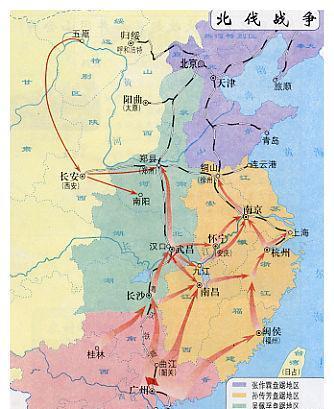
In July 1926, the Guangdong Nationalist Government held an oath-taking conference in Guangzhou, officially kicking off the prelude to the Northern Expedition. Although the 8 armies that initially participated in the Northern Expedition all fought under the same banner, the factions between the troops were still very complicated.
The 1st Army belonged to Chiang Kai-shek's Huangpu clan, the 3rd Army Zhu Peide belonged to the Dian clan, the 4th Army Li Jishen belonged to the Guangdong clan, the 5th Army Li Fulin belonged to the Green Forest Army, the 7th Army Li Zongren belonged to the Gui clan, and the 2nd Army Tan Yanmin, the 6th Army Cheng Qian, and the 8th Army Tang Shengzhi all came from the Hunan Xiang clan. Although these three armies have the same origin, they are not united with each other.
The 2nd Army was absorbed by Chiang Kai-shek
Tan Yanmin, the commander of the 2nd Army, was a veteran of the Xinhai Revolution, who had a great reputation in Hunan and served as the overseer of Hunan three times, but in the era of warlord melee, he was ousted by force three times. After the last time he stepped down, Tan Yanmin ran to Guangdong to join Sun Yat-sen, and it coincided with the 3rd and 6th Mixed Brigades of the Xiang Army in the War of Defending the Law, which was later renamed the "Founding Xiang Army" and assigned to tan Yanmin's command and stationed in Guangdong for a long time.
During the Northern Expedition, Tan Yanmin stayed in Guangdong together with Li Jishen and acted as chairman of the Kuomintang Central Committee. After March 1927, as a member of the Standing Committee of the Kuomintang Central Committee, a member of the Presidium of the Central Political Council, and a member of the Presidium of the Central Military Commission, Chiang Kai-shek launched the "April 12" Incident, and was once ready to encircle and disarm the 2nd Army under his command. Tan Yanmin once broke with Jiang and joined the camp of Wang Jingwei in Wuhan, but Jiang wang finally merged, and the 2nd Army still did not get rid of the fate of integration.
The 6th Army was first annexed by the Gui Clan and then by the Central Army
Cheng Qian, the 6th Army Veteran, was also a veteran of the Xinhai Revolution, serving as the head of the Hunan Military Department for a long time, leading the Xiang Army to conquer the north and south, and finally left due to discord with Tan Yanmin, who was in charge of Hunan, and served as the deputy commander of the army and the minister of military affairs under Sun Yat-sen, and recruited the old department, mastered the army, and actively participated in the battle against Chen Jiongming and other rebel forces. On January 6, 1926, the Kuomintang Political Committee decided to appoint Cheng Qian as the commander of the 6th Army.
After the start of the Northern Expedition, the 6th Army marched into Jiangxi, successively capturing Nanchang, Jiujiang and other places. On March 24, 1927, Cheng Qian led an army to occupy Nanjing. During the Ning-Han split, Cheng Qian joined hands with the Gui clan to first force Chiang Kai-shek to go into the wilderness, and then attacked the Tang Shengzhi clique that was entrenched in Wuhan. After the storm passed, the former ally Gui Shi suddenly turned his face and detained Cheng on charges such as "flying high and controlling Xiang Zheng". Coinciding with Chiang Kai-shek's comeback, Cheng was immediately dismissed from his post, and the 6th Army was leaderless and quickly divided and annexed.
The 8th Army was annexed by the Gui clan
Tang Shengzhi of the 8th Army should be the strongest of the 3 divisions, because he, like Li Zongren and Bai Chongxi of the 7th Army, had 1 provincial territory as the backing. After Tan Yanmin stepped down from the throne of the Hunan Overseer for the third time, zhao Hengti, the commander of the 1st Division, took over, and Tang Shengzhi was then the brigade commander under Zhao, and was promoted to the commander of the 4th Division because of his repeated meritorious achievements. In March 1926, Tang Shengzhi launched a mutiny and seized power in Hunan.
With the cooperation of the Northern Expeditionary Army, Tang Shengzhi repelled the counterattack of Zhao Hengti's old troops, and used Hunan as a base to fully participate in the Northern Expedition, absorbing a large number of defeated soldiers, and the strength expanded from the original 17 regiments to 35, because of its huge size, the 8th Army was expanded into the Fourth Front Army on February 1, 1927, still under the command of Tang Shengzhi. However, under the joint suppression of the Gui clan and Cheng Qian, Tang Sheng's zhibu soon collapsed, and the two lakes territory that had just been occupied fell into the hands of the Gui clan.
Although the Strength of the Xiang Clan in the Northern Expeditionary Army was not small, they did not help each other, and even dismantled each other, and eventually they were disintegrated one by one by Chiang Kai-shek and the Gui Clan, and finally he Jian, a rising star and commander of the 35th Army, stood out from the left and right of the Jiang and Gui clans and became the representative of the new generation of the Xiang Army.